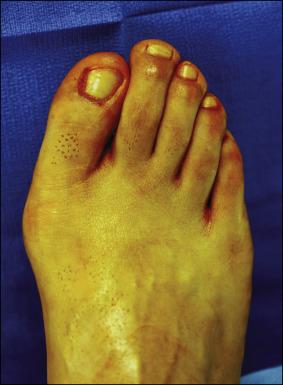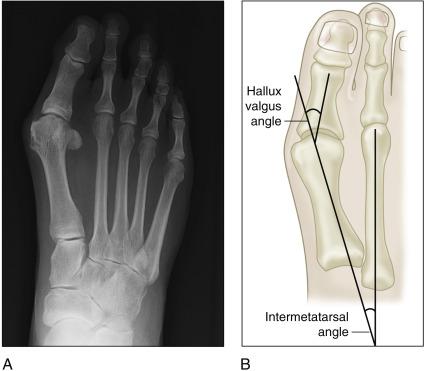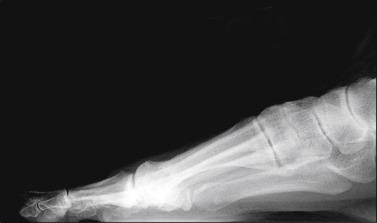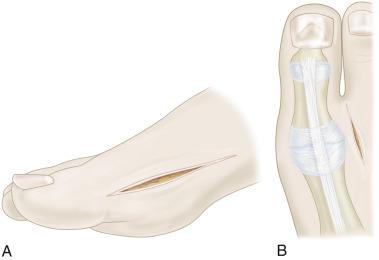Physical Address
304 North Cardinal St.
Dorchester Center, MA 02124
Painful hallux valgus deformity
Failure of shoe modification
Symptoms that interfere with daily activities
A mild to moderate deformity (hallux valgus angle <30º; intermetatarsal angle [IMA] <13–15°)
Patients with a high distal metatarsal articular angle (DMAA) require a chevron osteotomy with the addition of a closing wedge
Moderate arthritic changes of the joint are usually a contraindication to hallux valgus surgery.
A compromised blood supply.
Ulceration over the bunion prominence.
An IMA of >13–15°.
An extremely hypermobile first ray.
Osteoporosis makes this specific procedure more difficult because of poor screw fixation.
Patients with an excessively short first metatarsal may do better with a basilar opening wedge procedure (using an Arthrex low-profile plate) that does not further shorten the metatarsal.
Avascular necrosis of the metatarsal head is a reported complication of the chevron osteotomy but rarely occurs if the procedure is performed with precision.
Hallux valgus deformity will recur, to some degree, without some postoperative modification of high-heeled, tight-fitting shoes.
Hallux valgus correction with a proximal first metatarsal osteotomy is a much more powerful correction than a distal chevron. A proximal osteotomy (see Procedure 3 ) is a preferable procedure for moderate to severe bunion deformities. While it is possible to “push” the indications for a chevron, there is little point given the superb results of alternative procedures that involve a proximal osteotomy of the metatarsal base.
A patient with metatarsus adductus will have a spuriously low IMA on radiographs. A proximal osteotomy is often required in these patients, despite a low IMA.
Simultaneous bilateral bunionectomies are technically possible but present a very difficult recovery for the patient and are usually not recommended.
A self-drilling/tapping screw negates the difficult step of drilling across the osteotomy.
Shoe modification, with lower heels (<2.5 in.) and a wider toe box. Stretch the shoes over the bunion prominence.
Shoes should be purchased at the end of the day or after exercise, when the foot is most swollen.
A soft upper material is preferable. The shoe should stretch to fit the foot (i.e., do not deform the foot to fit the shoe).
A medial longitudinal arch support may be helpful in athletic footwear.
Standing examination of the foot demonstrates a hallux valgus deformity ( Fig. 1.1 ).

The bunion prominence is usually erythematous from footwear irritation.
Examine the interphalangeal (IP) joint to determine if a hallux interphalangeus is present (valgus IP angle >10°). A closing wedge osteotomy of the proximal phalanx may be needed for these cases.
Evaluate hypermobility of the first ray. A fusion of the metatarsal-cuneiform joint may be required, but not commonly.
Pes planus may be present in association with valgus of the heel. Simultaneous surgery for this condition is almost never required.
Standing anteroposterior (AP; Fig. 1.2 ) and lateral ( Fig. 1.3 ) radiographs of the foot:
Measure the first metatarsal-phalangeal angle and IMA (see Fig. 1.2B ). Determine if metatarsus adductus is causing a spuriously low IMA.
Measure the DMAA, which may require correction if >10°. Slight rotation of the foot can affect this radiographic angle, and intraoperative fluoroscopic evaluation may be needed.
Evaluate arthritic changes of the first metatarsophalangeal joint and the sesamoid-metatarsal articulation. Determine the station of the sesamoid (degree of subluxation from beneath the metatarsal head).


The patient is in the supine position.
A bump under the contralateral hip will externally rotate the leg, which will improve the exposure to the medial side of the foot.
An ankle or thigh tourniquet may be used.
The procedure is performed on an outpatient basis under a regional block (femoral-sciatic or popliteal-saphenous) to achieve maximal pain control postoperatively and reduce the amount of general anesthetic used.
Make a longitudinal incision over the medial eminence of adequate length to expose the metatarsal head and base of the proximal phalanx ( Fig. 1.6A ).
Isolate and protect the dorsal cutaneous sensory nerve (see Fig. 1.5B ).
Identify the medial plantar sensory nerve so that it is not injured during the procedure.

A 2-cm longitudinal incision in the first web space is usually required to release the lateral capsule and adductor tendon ( Fig. 1.6B ).
During surgery document any arthritic changes that may not have been visible on radiographs. Evaluate both sesamoids and the entire joint surface of the metatarsal head. Mild arthritis may cause symptoms that do not resolve postoperatively.
Become a Clinical Tree membership for Full access and enjoy Unlimited articles
If you are a member. Log in here